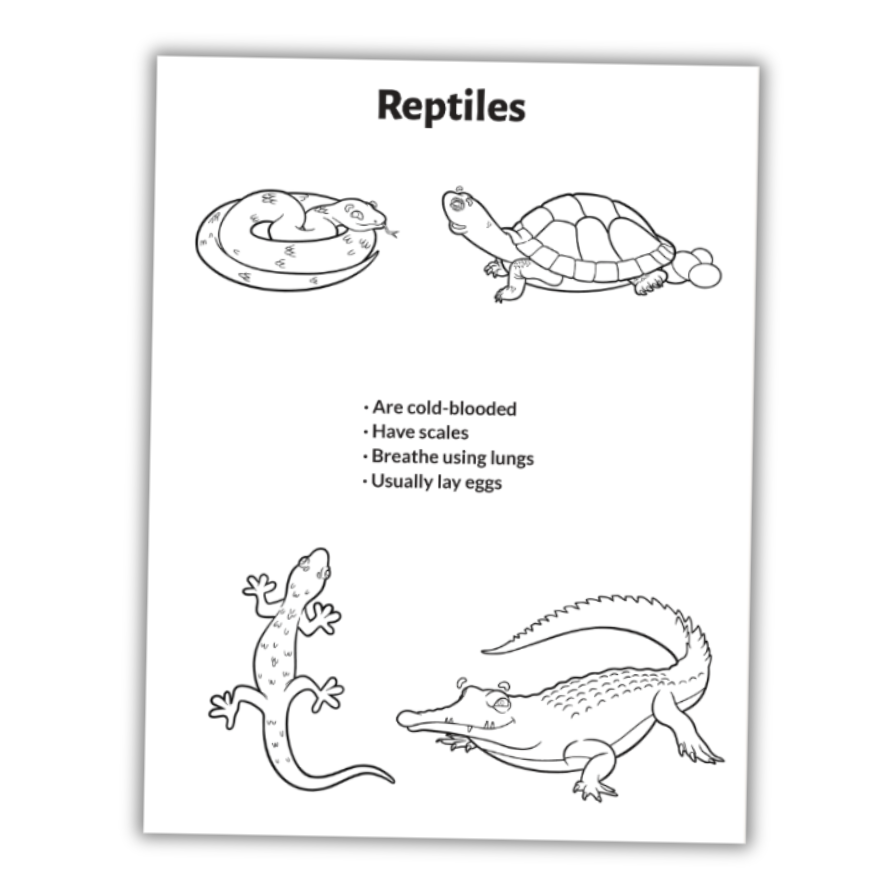Let’s continue our animal classification project by diving into the world of creepy-crawly reptiles. Teach your child to identify and classify examples of these cold-blooded critters. For many little ones, this is their favorite animal category!
Materials:
- Your animal characteristics poster that you began in Lesson 16
- Markers and crayons
- A source for your child to find pictures of reptiles: the internet, printer, and paper or magazines and scissors
- Glue stick
- Books about several different kinds of reptiles
- Whenever possible, source books that show real pictures of animals in their natural habitats and engaged in reptilian behaviors, such as laying eggs or sunning themselves.
- Reptile characteristics worksheet
- Optional: A variety of toy animals (plastic, stuffed, etc.) that include some reptiles and some mammals.
Tell your child that you’re going to continue learning about different types of animals and how to sort them into different categories. This week, you’ll learn about a group of animals called reptiles.

Before you begin talking about reptiles, review the characteristics of mammals with your child. Mammals are a group of animals that:
- Are warm-blooded*
- Have at least some hair or fur
- Feed their babies milk
Review the examples of mammals that you pasted on your animal chart.
Now, review the reptile characteristics worksheet with your child and let them color it. Talk about how reptiles are a group of animals that:
- Are cold-blooded*
- Have scales
- Breathe using lungs**
- Usually lay eggs (There are some reptiles that don’t.)
Talk about some familiar and notable examples of reptiles:
- Crocodiles
- Lizards
- Turtles
- Snakes
Read some books about different types of reptiles. Look at each picture and talk about the animals. Can you see its scales and nostrils? Is it sunning itself to get warm? What type of environment does it live in—in the desert, near the water?
Label one section of your poster board “Reptiles.” Together with your child, search online for different examples of reptiles or cut pictures from magazines. If your child points out an animal that is not a reptile, take the time to look it up and see what class it falls into. Glue the examples to the reptile section of your poster. If you find some great mammal examples, add those to the mammal section as well!
Optionally, you can get out your child’s stuffed animals or plastic animals and have your child sort them into reptiles, mammals, and other types of animals.
Save your poster for later!
Teaching moments:
- *If your child is unfamiliar with warm-blooded and cold-blooded animals, this is the perfect time to introduce those concepts. Warm-blooded animals can make their own heat and may feel warm to the touch, while cold-blooded animals are the same temperature as their surroundings and must move to a sunny or warm location to warm up.
- **The characteristics of reptiles could also equally apply to fish without this distinguishing factor. If you don’t want to get into a detailed anatomical lesson and explanation of lungs, show examples of fish—how they breathe using their gills—and reptiles—how they breathe through their nostrils.